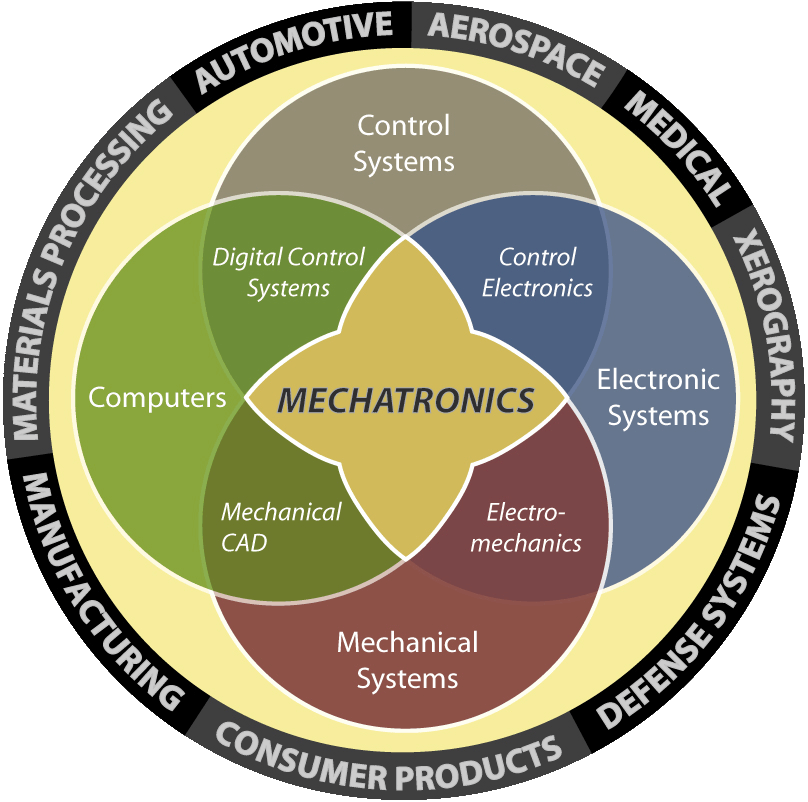Mechatronics
From Wikipedia, the free encyclopedia
Mechatronics (or Mechanical and Electronics Engineering) is the synergistic combination of mechanical engineering, electronic engineering, controls engineering, systems design engineering, and computer engineering to create useful products. The purpose of this interdisciplinary engineering field is the study of automata from an engineering perspective and serves the purposes of controlling advanced hybrid systems. The word itself is a combination of 'Mechanics' and 'Electronics'.
Contents |
[edit] History

Mechatronics is centred on mechanics, electronics, control engineering, computing, molecular engineering (from nanochemistry and biology) which, combined, make possible the generation of simpler, more economical, reliable and versatile systems. The portmanteau "Mechatronics" was first coined by Mr. Tetsuro Mori, a senior engineer of the Japanese company Yaskawa, in 1969. Mechatronics may alternatively be referred to as "electromechanical systems" or less often as "control and automation engineering".
[edit] Description
Engineering cybernetics deals with the question of control engineering of mechatronic systems. It is used to control or regulate such a system (see control theory). Through collaboration the mechatronic modules perform the production goals and inherit flexible and agile manufacturing properties in the production scheme. Modern production equipment consists of mechatronic modules that are integrated according to a control architecture. The most known architectures involve hierarchy, polyarchy, hetaerachy (often misspelled as heterarchy) and hybrid. The methods for achieving a technical effect are described by control algorithms, which may or may not utilize formal methods in their design. Hybrid-systems important to Mechatronics include production systems, synergy drives, planetary exploration rovers, automotive subsystems such as anti-lock braking systems, spin-assist and every day equipment such as autofocus cameras, video, hard disks, CD-players.
A typical mechatronic engineering degree would involve classes in engineering mathematics, mechanics, machine component design, mechanical design, thermodynamics, circuits and systems, electronics and communications, control theory, programming, digital signal processing, power engineering, robotics and usually a final year thesis.
[edit] Application
- Automation, and in the area of robotics
- Servo-mechanics
- Sensing and control systems
- Automotive engineering, in the design of subsystems such as anti-lock braking systems
- Computer engineering, in the design of mechanisms such as computer drives
[edit] Variant of the field
An emerging variant of this field is biomechatronics, whose purpose is to integrate mechanical parts with a human being, usually in the form of removable gadgets such as exoskeleton. This is the “real-life” version of cyberware.
[edit] See also
- Biomechatronics
- Cybernetics
- List of engineering topics
- National Instruments
- Robotics
- Systems Engineering
- Mechatronics Journals
[edit] References
- Bradley, Dawson et al., Mechatronics, Electronics in products and processes, Chapman and Hall Verlag, London, 1991.
- Karnopp, Dean C., Donald L. Margolis, Ronald C. Rosenberg, System Dynamics: Modeling and Simulation of Mechatronic Systems, 4th Edition, Wiley, 2006. ISBN 0-471-70965-4 Bestselling system dynamics book using bond graph approach.
- Cetinkunt, Sabri, Mechatronics, John Wiley & Sons, Inc, 2007 ISBN 978-0-4714798-1
[edit] External links
- Introduction to Mechatronics
- Mechatronics training systems
- General to Mechatronics
- Mechatronics Course - Brazil

